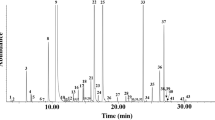Abstract
This work reports the maximization of eugenyl acetate production by esterification of essential oil of clove in a solvent-free system using Novozym 435 as catalyst. The antimicrobial and antioxidant activities of clove essential oil and eugenyl acetate produced were determined. The conditions that maximized eugenyl acetate production were 60 °C, essential oil of clove to acetic anhydride ratio of 1:5, 150 rpm, and 10 wt% of enzyme, with a conversion of 99.87 %. A kinetic study was performed to assess the influence of substrates’ molar ratio, enzyme concentration, and temperature on product yield. Results show that an excess of anhydride, enzyme concentration of 5.5 wt%, 50 °C, and essential oil of clove to acetic anhydride ratio of 1:5 afforded nearly a complete conversion after 2 h of reaction. Comparing the antibacterial activity of the essential oil of clove before and after esterification, we observed a decrease in the antimicrobial activity of eugenyl acetate, particularly with regard to minimum inhibitory concentration (MIC). Both eugenyl acetate and clove essential oil were most effective to the gram-negative than gram-positive bacteria group. The results showed a high antioxidant potential for essential oil before and particularly after the esterification reaction thus becoming an option for the formulation of new antioxidant products.




Similar content being viewed by others
References
Paoli, S., Giani, T. S., Presta, G. A., Pereira, M. P., Fonseca, A. S., Brandão Neto, J., et al. (2007). Brazilian Archives of Biology and Technology, 50, 175–182.
Guenette, S. A., Rodd, A., Marier, J. F., Beaudry, F., & Vachon, P. (2007). European Journal of Pharmacology, 562, 60–67.
Guenette, S. A., Helie, P., Beaudry, F., & Vachon, P. (2007). Veterinary Anaesthesia and Analgesia, 34, 164–170.
Affonso, R. S., Rennó, M. N., Slana, G. B. C. A., & França, T. C. C. (2012). Revista Virtual de Química, 4, 146–161.
Chaieb, K., Hajlaoui, H., Zmantar, T., Kahla-Nabki, A. B., Rouabhia, M., Mahdouani, K., et al. (2007). Phytotherapy Research, 21, 501–506.
Chiaradia, V., Paroul, N., Cansian, R. L., Júnior, C. V., Detofol, M. R., Lerin, L. A., et al. (2012). Applied Biochemistry and Biotechnology, 168, 742–751.
Silvestri, J. D. F., Paroul, N., Czyewski, E., Lerin, L., Rotava, I., Cansian, R. L., et al. (2010). Revista Ceres, 57, 589–594.
Scherer, R., Wagner, R., Duarte, M. C. T., & Godoy, H. T. (2009). Brazilian Journal of Medicinal Plants, 11, 442–449.
Paroul, N., Grzegozeski, L. P., Chiaradia, V., Treichel, H., Cansian, R. L., Oliveira, J. V., et al. (2011). Bioprocess and Biosystems Engineering, 34, 331–337.
Paroul, N., Grzegozeski, L. P., Chiaradia, V., Treichel, H., Cansian, R. L., Oliveira, J. V., et al. (2010). Journal of Chemical Technology and Biotechnology, 85, 1636–1641.
Liaw, E. T., & Liu, K. J. (2010). Bioresource Technology, 101, 3320–3324.
Aguedo, M., Belo, I., Ly, M. H., Teixeira, J. A., Belin, J. M., & Waché, Y. (2004). Food Technology and Biotechnology, 42, 327–336.
Bartling, K., Thompson, J. U. S., Pfromm, P. H., Czermak, P., & Rezac, M. E. (2001). Biotechnology and Bioengineering, 75, 676–681.
Valério, A., Fiametti, K. G., Rovani, S., Franceschi, E., Corazza, M. L., Treichel, H., et al. (2009). Journal of Supercritical Fluids, 49, 216–220.
Yang, T., Rebsdorf, M., Engelrud, U., & Xu, X. (2005). Journal of Agricultural and Food Chemistry, 53, 1475–1481.
Watanabe, T., Shimizu, M., Sugiura, M., Sato, M., Kohori, J., Yamada, N., et al. (2003). Journal of the American Oil Chemists Society, 80, 1201–1207.
Karra-Châabouni, M., Ghamghi, H., Bezzine, S., Rekik, A., & Gargouri, Y. (2006). Process Biochemistry, 41, 1692–1698.
Horchani, H., Salem, N. B., Zarai, Z., Sayari, A., Gargouri, Y., & Chaâbouni, M. (2010). Bioresource Technology, 101, 2809–2817.
Chaibakhsh, N., Basri, M., Anuar, S. H. M., Rahman, M. B. A., & Rezayee, M. (2012). Biocatalysis and Agricultural Biotechnology, 1, 226–231.
Yadav, G. D., & Yadav, A. R. (2012). Chemical Engineering Journal, 192, 146–155.
Paroul, N., Grzegozeski, L. P., Chiaradia, V., Treichel, H., Cansian, R. L., Oliveira, J. V., et al. (2011). Applied Biochemistry and Biotechnology, 166, 13–21.
Katzung, B. G. (2003). Farmacologia Básica e Clínica (8th ed.). Koogan: Rio de Janeiro – Guanabara.
Holley, R. A., & Patel, D. (2005). Food Microbiology, 22, 273–292.
Klancnik, A., Piskernik, S., Jersek, B., & Mozina, S. S. (2010). Journal of Microbiological Methods, 81, 121–126.
Dorman, H. J. D., & Deans, S. G. (2000). Journal of Applied Microbiology, 88, 308–316.
Lachowicz, K. J., Jones, G. P., Briggs, D. R., Bienvenu, F. E., Wan, J., Wilcock, A., et al. (1998). Letters in Applied Microbiology, 26, 209–214.
Pei, R. S., Zhou, F., Ji, B. P., & Xu, J. (2009). Journal of Food Science, 74, 379–383.
Ultee, A., Bennik, M. H. J., & Moezelaar, R. (2002). Applied and Environmental Microbiology, 68, 1561–1568.
Burt, S. A. (2004). International Journal of Food Microbiology, 94, 223–253.
Skandamis, P., Tsigarida, E., & Nychas, G. J. E. (2002). Food Microbiology, 19, 97–103.
Mensor, L. L., Menezes, F. S., Leitão, G. G., Reis, A. S., Santos, T. C., Coube, C. S., et al. (2001). Phytotherapy Research, 15, 127–130.
Ramalho, V. C., & Jorge, N. (2006). Quimica Nova, 29, 755–760.
Balasundram, N., Sundram, K., & Samman, S. (2006). Food Chemistry, 99, 191–203.
Acknowledgments
The authors thank the CNPq, CAPES, FAPERGS, and SCIT-RS for financial support.
Author information
Authors and Affiliations
Corresponding author
Rights and permissions
About this article
Cite this article
Vanin, A.B., Orlando, T., Piazza, S.P. et al. Antimicrobial and Antioxidant Activities of Clove Essential Oil and Eugenyl Acetate Produced by Enzymatic Esterification. Appl Biochem Biotechnol 174, 1286–1298 (2014). https://doi.org/10.1007/s12010-014-1113-x
Received:
Accepted:
Published:
Issue Date:
DOI: https://doi.org/10.1007/s12010-014-1113-x




